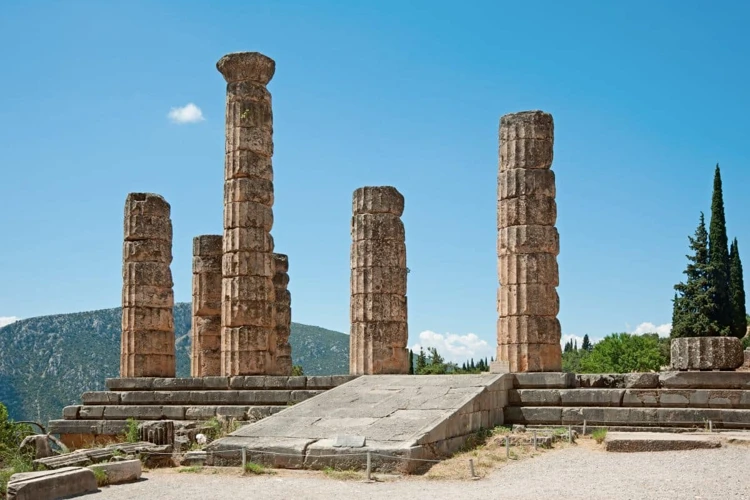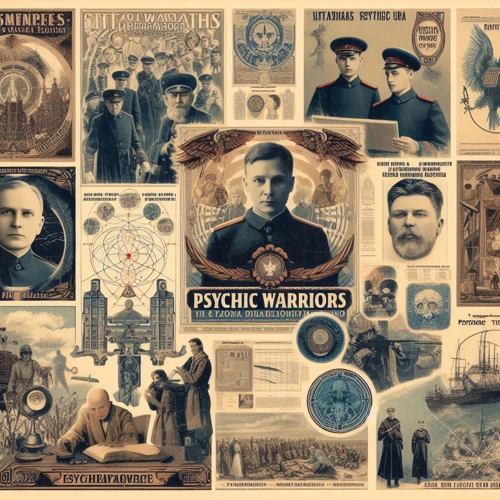The Oracle of Delphi has long been shrouded in mystery and intrigue, captivating the imagination of historians, spiritualists, and skeptics alike. For centuries, people have been fascinated by the prophecies that emanated from the ancient sanctuary in Delphi, Greece. The enigmatic Pythia, the priestess who served as the oracle, was believed to communicate with the gods and offer insights into the future. In this article, we will delve into the historical background and spiritual significance of the Oracle of Delphi, explore the process by which the prophecies were obtained, and unravel the mysteries surrounding their interpretation. Additionally, we will discuss the controversies and skepticism surrounding the oracle, as well as its profound influence on politics, military campaigns, and art. Join us on this captivating journey as we unravel the secrets of the Oracle of Delphi.
Contents
- The Oracle of Delphi
- The Prophecies
- Unraveling the Mystery
- Controversies and Skepticism
- The Influence of the Oracle
- Conclusion
-
Frequently Asked Questions
- 1. What was the historical significance of the Oracle of Delphi?
- 2. Who were the Pythia and how were they chosen?
- 3. How were the prophecies obtained at Delphi?
- 4. How were these cryptic prophecies interpreted?
- 5. What evidence supports the existence of the Oracle of Delphi?
- 6. Were the prophecies of the Oracle of Delphi always accurate?
- 7. What were some of the controversies surrounding the Oracle of Delphi?
- 8. How did the Oracle of Delphi influence art and culture?
- 9. Did the Oracle of Delphi have an impact beyond Greece?
- 10. What is the modern significance of the Oracle of Delphi?
- References
-
Frequently Asked Questions
- 1. How accurate were the prophecies of the Oracle of Delphi?
- 2. Who was the Pythia, and what was her role in delivering the prophecies?
- 3. How did the Delphic Oracle’s process work?
- 4. What were some of the challenges faced in interpreting the prophecies?
- 5. What kind of ancient manuscripts provide insight into the prophecies?
- 6. Have there been any significant archaeological discoveries related to the Oracle of Delphi?
- 7. How does linguistic analysis help in unraveling the mystery of the prophecies?
- 8. What scientific explanations exist for the prophecies of the Oracle of Delphi?
- 9. How did the prophecies of the Oracle of Delphi impact politics and military strategies?
- 10. In what ways did the Oracle of Delphi inspire cultural and artistic creations?
- References
- Read More
The Oracle of Delphi

The Oracle of Delphi, an ancient sanctuary dedicated to the god Apollo, holds a mystical aura that continues to captivate modern-day imaginations. Nestled on the slopes of Mount Parnassus, this sacred site was once home to the enigmatic Pythia – a powerful priestess believed to be a conduit between the mortal realm and the divine. People from far and wide would journey to seek her prophetic wisdom on matters pertaining to politics, war, and personal fortunes. Legends abound of the Pythia’s trances and cryptic utterances, which were then deciphered by priests. These prophecies shaped the course of history and influenced the decisions of kings and emperors. Today, the ruins of Delphi still stand as a testament to the significance and intrigue surrounding this ancient oracle. Link to uncovering ancient stories of the Zodiac constellations.
1. Historical Background
The historical background of the Oracle of Delphi is steeped in ancient mythology and legendary tales. According to Greek mythology, Zeus released two eagles from opposite ends of the world, and they met at Delphi, thus marking it as the center of the world. Delphi became a sacred site dedicated to Apollo, the god of prophecy and healing. The oracle was believed to have been established around the 8th century BCE and remained highly influential until its decline in the 4th century CE. Throughout its existence, Delphi was at the crossroads of political and military struggles, attracting visitors from all walks of life seeking guidance and counsel. The oracle’s reputation for accuracy and wisdom grew, further solidifying its position as a leading spiritual and political authority in the ancient world. Link to exploring Ophiuchus in music, songs, and lyrics.
2. Spiritual Significance
The spiritual significance of the Oracle of Delphi is deeply rooted in ancient Greek religious beliefs and practices. The sanctuary was considered the dwelling place of the god Apollo, who was associated with prophecy, healing, and music. The Pythia, as the intermediary between the mortal world and the divine, held immense spiritual authority. She was believed to be possessed by Apollo himself during her trance-like state, allowing her to communicate with the gods and offer glimpses into the future. This spiritual connection with the divine made the Oracle of Delphi a revered and respected institution in the ancient world. The prophecies and advice provided by the oracle served as guidance for individuals, communities, and even rulers seeking divine counsel. The sanctuary itself was considered a sacred space where people could connect with the divine, leaving offerings and making dedications to honor the gods. The spiritual significance of the Oracle of Delphi endures to this day, as it continues to inspire awe and intrigue, and reminds us of the ancient Greeks’ profound belief in the power of the divine. Link to compatibility between Sun and Venus signs in love.
The Prophecies

The Prophecies of the Oracle of Delphi were sought after by both individuals and nations seeking insight into their future. Central to these prophecies was the role of the Pythia, the priestess of the Oracle. The Pythia, believed to be possessed by the god Apollo, would enter a trance-like state and deliver her prophecies in cryptic and ambiguous language. These prophetic utterances were then interpreted by the priests of the sanctuary, who acted as intermediaries between the Pythia and the seekers of divine guidance. The process of obtaining these prophecies was a rigorous one, involving purification rituals, sacrifices, and precise questioning. However, the interpretation of these messages was not without its challenges. The cryptic nature of the prophecies and the poetic language used often left room for multiple interpretations, leading to confusion and ambiguity. Despite these challenges, the prophecies of the Oracle were highly regarded and influential, shaping the decisions of individuals and even impacting the course of major historical events.
1. The Role of the Pythia
The role of the Pythia in the Oracle of Delphi was of utmost importance. The Pythia, also known as the Delphic Oracle, was the priestess who served as the medium through which the prophecies were communicated. Chosen from a young age, the Pythia would undergo a rigorous selection process to ensure her purity and connection to the gods. Once selected, she would assume her duties at the temple, where she would enter a trance-like state to receive the messages from Apollo. This process involved inhaling the fumes emitted from a chasm in the temple floor, which were believed to induce the prophetic state. While in this altered state of consciousness, the Pythia would utter her prophecies, often in a state of frenzy or ecstasy. These utterances were then interpreted and recorded by the attending priests, who would formulate them into coherent responses for those seeking guidance. The Pythia’s role was not only to deliver the prophecies but also to embody the power and authority of the gods, and her words carried great weight in the ancient world. The position of the Pythia was held in high esteem, and her pronouncements had the potential to shape the destiny of nations.
2. The Delphic Oracle’s Process
The Delphic Oracle’s Process:
1. Selection and Preparation of the Pythia: The Pythia, or priestess of the Oracle, was chosen through a rigorous process. She had to be a mature woman of good character, free of any physical or mental ailments. Before assuming her role, she underwent a period of purification, which included cleansing rituals and abstaining from certain foods.
2. Sacred Rituals and Offerings: The process of receiving prophecies from the Delphic Oracle involved a series of sacred rituals and offerings. The Pythia would don a special ceremonial robe and enter the inner sanctuary of the temple. Here, she would purify herself once again before taking her seat on a tripod positioned above a fissure in the earth, known as the “omphalos.”
3. Induced Trance State: To enter a trance state and communicate with the gods, the Pythia would inhale the fumes rising from a chasm in the ground. These vapors were believed to possess prophetic powers, inducing an altered state of consciousness. In this trance, the Pythia would receive messages from the gods, which would then be relayed to the priests and interpreted.
4. Priestly Interpretation: The utterances of the Pythia were often cryptic and open to multiple interpretations. The priests of the temple played a crucial role in deciphering these messages and providing guidance to the seekers. They would carefully analyze the Pythia’s words, often in poetic form, and interpret their meaning in relation to the specific inquiries brought before the oracle.
5. Recording and Propagating the Prophecies: The prophecies obtained from the Delphic Oracle were considered sacred and were recorded on various mediums like inscriptions, scrolls, and oral traditions. These prophecies were then disseminated to the seekers, who would use the guidance to shape their actions and decisions.
The Delphic Oracle’s Process was a complex and multifaceted endeavor, steeped in ancient rituals and beliefs. It required the synchronized efforts of the selected Pythia, the priests, and the seekers themselves to unravel the enigmatic messages from the gods. Despite the veil of mystery that surrounds this process, it remained an influential and sought-after source of divine wisdom in the ancient world.
3. Interpretation Challenges
Interpreting the prophecies of the Oracle of Delphi presents a multitude of challenges that have confounded scholars and historians for centuries. One of the primary difficulties lies in the ambiguous nature of the Pythia’s utterances. Her words were cryptic and often open to multiple interpretations, leaving room for subjective understanding. The prophecies were delivered in a poetic form known as hexameter, further complicating the task of deciphering their true meaning. Additionally, the prophecies were often veiled in symbolism and metaphor, requiring a deep understanding of the cultural and mythological context in which they were given. Another challenge stems from the fact that the prophecies were relayed from the Pythia to the priests who then translated them into prose. This intermediary step increased the likelihood of errors or misinterpretation, adding another layer of complexity to the process. The passing of time has resulted in the loss or distortion of some of the original prophecies, making it even more challenging to reconstruct their intended message. Despite these formidable hurdles, scholars continue to explore and analyze the prophecies, employing various methods of textual analysis, cultural examination, and historical context to shed light on their true meanings. The interpretation challenges of the Oracle of Delphi’s prophecies serve as a reminder of the profundity and enigmatic nature of ancient knowledge.
Unraveling the Mystery

Unraveling the Mystery surrounding the Oracle of Delphi requires meticulous examination of various sources and evidence. Ancient manuscripts, such as the writings and accounts of historians like Herodotus and Plutarch, offer valuable insights into the rituals and practices of the oracle. These texts provide a glimpse into the role of the Pythia, her trance-induced state, and the process of receiving and interpreting prophecies. Additionally, archaeological discoveries, such as the ruins of the temple at Delphi and the artifacts found within, shed light on the physical aspects of the oracle’s operations. Linguistic analysis of inscriptions and texts uncovered at Delphi further aids in deciphering the cryptic messages delivered by the oracle. By piecing together these puzzle-like fragments, scholars and researchers slowly but surely decode the enigma of the Oracle of Delphi, bridging the gap between the mysterious past and the present.
1. Ancient Manuscripts
Ancient manuscripts play a crucial role in unraveling the mysterious prophecies of the Oracle of Delphi. These invaluable documents provide a glimpse into the rituals, practices, and specific prophecies of the Pythia. One notable collection of ancient manuscripts is known as the “Delphic Maxims.” These maxims, inscribed on stone tablets and exhibited at the sanctuary, contain concise words of wisdom attributed to the gods. While not explicitly prophetic, they offer insights into the moral and ethical teachings upheld by the Oracle. Another significant manuscript, the “Hymn to Apollo,” provides a poetic account of the birth and divine powers of the god Apollo, who was believed to inspire the prophecies. Additionally, the Pithoi Inscriptions, which were discovered in a storage pit at Delphi, contain numerous fragments that shed further light on the pronouncements made by the Pythia. These ancient manuscripts serve as invaluable resources for historians, providing glimpses into the process, language, and content of the prophecies, enabling us to further understand the significance and intricacies of the Oracle of Delphi.
2. Archaeological Discoveries
Archaeological discoveries have played a pivotal role in unraveling the mysteries of the Oracle of Delphi. Over the years, numerous excavations have unearthed significant artifacts that shed light on the practices and rituals of this ancient sanctuary. One of the most notable findings was the Oracle’s sanctuary itself, which included a grand temple dedicated to Apollo. This temple, adorned with exquisite sculptures and inscriptions, served as the focal point for pilgrims seeking divine guidance. Additionally, archaeologists unearthed the remains of the Tholos of Delphi, a circular building believed to have been used for important ceremonies related to the Oracle. The discovery of offerings made to Apollo, such as statues, jewelry, and precious metals, revealed the devotion and reverence that ancient Greeks had for the Oracle. The excavation of the theater of Delphi provided insights into the cultural and artistic events that took place in the vicinity of the sanctuary. These archaeological findings have not only provided tangible evidence of the Oracle’s existence but have also deepened our understanding of the religious and cultural significance it held in ancient Greek society.
3. Linguistic Analysis
Linguistic analysis plays a crucial role in unraveling the mysteries of the prophecies from the Oracle of Delphi. Scholars and experts have delved into the ancient texts and inscriptions associated with the oracle, employing various linguistic techniques to decipher the meanings hidden within. One approach is comparative linguistics, where similarities between the Delphic inscriptions and other ancient languages are examined. This helps shed light on the linguistic origins and potential influences of the oracular utterances. Another method is syntactic analysis, which focuses on the arrangement and structure of words and phrases within the prophecies. By examining the grammar and syntax, linguists can uncover patterns and possible interpretations. Additionally, semantic analysis is employed to decode the meaning of individual words and symbols used in the prophecies. This involves examining cultural context, historical records, and linguistic symbolism to unravel the layers of metaphor and allegory present in the oracle’s messages. Linguistic analysis acts as a powerful tool in unlocking the secrets hidden within the enigmatic prophecies of the Oracle of Delphi, allowing us to gain deeper insights into the mysteries of the ancient world.
Controversies and Skepticism

Controversies and skepticism have long surrounded the Oracle of Delphi and its prophecies. While many believed in the mystical power of the Pythia, others approached the oracle with a heavy dose of skepticism and sought rational explanations. Some scientists attribute the Pythia’s prophetic visions to natural geological phenomena, such as volcanic gases, which may have induced altered states of consciousness. Alternatively, psychological perspectives suggest that the Pythia’s trances and cryptic utterances were the result of suggestion, psychological manipulation, or even the ingestion of hallucinogenic substances. These differing viewpoints have sparked debates among scholars and experts, questioning the authenticity and validity of the Oracle of Delphi’s prophecies. Despite the controversies, one cannot deny the lasting impact and cultural significance the oracle has had throughout history. Link to exploring Ophiuchus in music, songs, and lyrics.
1. Scientific Explanations
Scientific explanations have been put forth over the years to demystify the enigmatic prophecies of the Oracle of Delphi. One such theory suggests that the intoxicating fumes emanating from the geological formations in the sanctuary area, such as ethylene gas, may have played a role in the Pythia’s altered state of consciousness. This hypothesis posits that the priestess, while in a trance-like state induced by these naturally occurring gases, may have experienced hallucinations and made prophecies based on her altered perception.
Another scientific perspective proposes that the Pythia’s cryptic messages were influenced by the power of suggestion. It suggests that the questions posed by the visitors to the oracle, along with the ambiguous and open-ended nature of the prophecies, allowed for a wide range of interpretations. The priestly interpreters, skilled in the art of rhetoric and manipulation, may have guided the seekers towards specific interpretations that served their own interests or the interests of the ruling elite.
Advancements in neurobiology and psychology have shed light on the role of psychological factors in the oracle’s prophecies. Some researchers argue that the Pythia’s altered state of consciousness may have been induced by self-hypnosis techniques or a form of dissociative disorder. This altered state, combined with the ceremonial and ritualistic environment, could have heightened the Pythia’s suggestibility and susceptibility to interpreting her perceptions in a prophetic manner.
While these scientific explanations provide fascinating insights into the possible mechanisms behind the oracle’s prophecies, they do not discount the deep spiritual significance attributed to the Oracle of Delphi by ancient Greeks and visitors from around the Mediterranean. The enduring allure and impact of the prophecies continue to fuel debates and intrigue to this day.
2. Psychological Perspectives
Psychological perspectives offer intriguing insights into the phenomenon of the Oracle of Delphi. Psychologists and scholars have explored various theories and explanations for the prophetic experiences of the Pythia and those who sought her guidance. One perspective suggests that the Pythia may have entered altered states of consciousness, such as trance or hallucinations, induced by the fumes emitted from the sacred chamber. This altered state of mind could have heightened sensory experiences and led to distorted perceptions and mystical visions. Another psychological perspective proposes that the Pythia’s prophecies were a manifestation of the collective unconscious, tapping into a shared pool of archetypal symbols and themes that are deeply ingrained in human psyche. This perspective draws connections between the Pythia’s cryptic utterances and the universal symbols and themes found in dreams and myths. Psychologists have also explored the role of suggestion and expectancy in the belief and interpretation of the prophecies. It is suggested that the power of suggestion, combined with the seekers’ own desires and expectations, may have influenced the perceived accuracy and significance of the oracle’s messages. These psychological perspectives shed light on the intricacies of the human mind and its capacity to create and interpret mystical experiences and prophetic visions.
The Influence of the Oracle

The influence of the Oracle of Delphi extended far beyond the realm of divination. Its prophecies held sway over political and military decision-making, shaping the course of Greek and Roman history. Kings, warlords, and statesmen would consult the Oracle for advice before embarking on campaigns, establishing alliances, or making crucial policy decisions. The prophecies were often interpreted as divine endorsement or warnings, giving individuals and nations a sense of direction and purpose. For example, the Oracle played a significant role in the Persian Wars, as both the Greeks and the Persians sought divine validation for their respective causes. The impact of the Oracle went beyond the political and military realms, influencing and inspiring artistic and cultural endeavors as well. Artists, playwrights, and musicians sought the Oracle’s blessings and guidance in their creative pursuits, believing that divine favor would lead to masterpieces and artistic success. The Oracle’s influence permeated every facet of society, leaving an indelible mark on ancient Greek and Roman civilization.
1. Political and Military Impact
The Oracle of Delphi held immense political and military influence, with the prophecies shaping the decisions and actions of leaders and warriors. Kings and emperors sought the oracle’s guidance before embarking on military campaigns, believing that the endorsement of the gods would ensure victory. The prophecies provided strategic insights, such as advising on the timing of attacks or warning against ill-fated endeavors. One notable example is King Croesus of Lydia, who consulted the oracle and received what he perceived as a favorable response. However, his misinterpretation of the prophecy led to a disastrous military defeat. The oracle’s influence extended beyond military matters, as political leaders sought her guidance to solidify their rule or make important policy decisions. The endorsement of the oracle legitimized rulers and united communities under their leadership. Additionally, the oracle’s prophecies were often used to justify political decisions, providing a divine validation for controversial actions. The political and military impact of the Oracle of Delphi cannot be overstated, as it played a pivotal role in shaping the course of ancient civilizations.
2. Cultural and Artistic Inspiration
Cultural and artistic inspiration flowed abundantly from the Oracle of Delphi. The prophecies and the aura of divinity associated with the oracle had a profound impact on the arts and culture of ancient Greece. Poets, playwrights, and musicians sought to capture the mystique of Delphi in their works. They drew inspiration from the prophetic utterances and wove them into their creations. The tragedies of Aeschylus, Sophocles, and Euripides often incorporated elements of Delphic prophecy, exploring themes of fate, destiny, and the consequences of human actions. The Delphic Oracle also played a significant role in the creation of the legendary Twelve Labors of Heracles, as the oracle’s prophecies were woven into the hero’s epic journey. Additionally, the visual arts were influenced by the Oracle of Delphi, as sculptures and paintings depicted scenes associated with the sanctuary and the Pythia. The artistic legacy of Delphi extended beyond ancient Greece, with later civilizations such as the Romans also being captivated by its allure. The influence of the Delphic Oracle on ancient culture and the arts reverberates through the ages, showcasing the enduring significance of its prophecies and its ability to ignite the creative spirit.
Conclusion

In conclusion, the Oracle of Delphi remains an enigmatic phenomenon that has fascinated people throughout history. The prophecies delivered by the Pythia at the sanctuary in Delphi held immense spiritual and political significance. While the exact process and interpretation of these prophecies may forever be shrouded in mystery, various sources such as ancient manuscripts, archaeological discoveries, and linguistic analysis have shed some light on the subject. However, controversies and skepticism surround the oracle, with scientific explanations and psychological perspectives offering alternative viewpoints. Regardless, the influence of the Oracle of Delphi cannot be denied. Its prophecies shaped political and military decisions, and its aura inspired countless works of art and literature. The Oracle of Delphi stands as a testament to the enduring allure of the past, and the continuing quest for unraveling the mysteries of ancient civilizations.
Frequently Asked Questions

1. What was the historical significance of the Oracle of Delphi?
The Oracle of Delphi played a crucial role in ancient Greek society. It held considerable political and military influence, with leaders seeking advice from the Pythia on matters of state and warfare.
2. Who were the Pythia and how were they chosen?
The Pythia were priestesses selected from local families near Delphi. They were believed to be chosen by the gods themselves and underwent rigorous training and purification rituals before assuming their role as oracles.
3. How were the prophecies obtained at Delphi?
The prophecies were obtained through a process known as “divination.” The Pythia would enter a trance-like state, possibly induced by inhaling sacred fumes, and utter cryptic messages believed to be revelations from the gods.
4. How were these cryptic prophecies interpreted?
The cryptic nature of the prophecies often made interpretation challenging. Priests known as “prophets” would carefully analyze the Pythia’s words, looking for hidden meanings and symbolism that could provide insights into the future events.
5. What evidence supports the existence of the Oracle of Delphi?
Archaeological excavations have uncovered the remains of the sanctuary, including the Temple of Apollo and the theater. Ancient texts, such as the works of Herodotus and Plutarch, also provide detailed accounts of the oracle and its prophecies.
6. Were the prophecies of the Oracle of Delphi always accurate?
The accuracy of the prophecies is a matter of debate. While some prophecies were remarkably accurate, others were vague or open to interpretation. It is also possible that political influences or biases may have influenced the Pythia’s pronouncements.
7. What were some of the controversies surrounding the Oracle of Delphi?
Controversies included allegations of fraud, manipulation, and bribery. Some skeptics believe that the Oracle’s prophecies were based on clever guesswork rather than divine inspiration.
8. How did the Oracle of Delphi influence art and culture?
The prophecies of the Delphic Oracle inspired numerous works of art, literature, and drama. Ancient playwrights like Aeschylus and Sophocles often incorporated the Oracle’s prophecies into their plays, adding a sense of intrigue and mystery.
9. Did the Oracle of Delphi have an impact beyond Greece?
Absolutely. The reputation of the Oracle extended beyond Greece, attracting visitors and supplicants from across the ancient world. Its influence reached as far as Rome and influenced the decisions of emperors and military leaders.
10. What is the modern significance of the Oracle of Delphi?
Today, the Oracle of Delphi continues to capture the imagination of people worldwide. It serves as a reminder of the ancient world’s fascination with the mystical and the enduring allure of seeking guidance from a higher power.
References
- The Mystery of The Oracle of Delphi: Finally Exposed
- The Oracle: Lost Secrets and Hidden… by Broad, William J.
Frequently Asked Questions

1. How accurate were the prophecies of the Oracle of Delphi?
The accuracy of the prophecies of the Oracle of Delphi has been a subject of debate. While some prophecies were accurate, others were vague or open to multiple interpretations. It is believed that the oracle’s words were often cryptic and required careful analysis to understand their true meaning.
2. Who was the Pythia, and what was her role in delivering the prophecies?
The Pythia was the priestess of the Oracle of Delphi, chosen from among young women of high social standing. Her role was to enter a state of trance induced by the fumes of the sacred tripod and deliver the prophecies in the form of cryptic and enigmatic verses, which were then interpreted by priests.
3. How did the Delphic Oracle’s process work?
The process at the Delphic Oracle involved several steps. Pilgrims would first purify themselves in the Castalian Spring and then offer sacrifices to the god Apollo. They would then present their questions to the Pythia, who would enter a trance-like state and deliver her prophecies. The priests would interpret these prophecies and convey them to the pilgrims.
4. What were some of the challenges faced in interpreting the prophecies?
The prophecies delivered by the Oracle of Delphi were often cryptic and open to interpretation. The poetic nature of the verses added to the challenge of understanding their true meaning. Additionally, the language used by the Pythia was believed to be influenced by the god Apollo, making it difficult to disentangle the divine message from human error or bias.
5. What kind of ancient manuscripts provide insight into the prophecies?
Ancient manuscripts such as the “Delphic Maxims” and the writings of Plutarch offer valuable insights into the prophecies of the Oracle of Delphi. These texts provide descriptions of the oracle’s process, anecdotes about specific prophecies, and discussions on the interpretation of the cryptic verses.
Yes, there have been several archaeological discoveries that shed light on the Oracle of Delphi. The most notable is the discovery of the Temple of Apollo, where the Oracle delivered her prophecies. Excavations have also revealed offerings made by pilgrims, including statues, jewelry, and inscriptions, providing further evidence of the oracle’s influence.
7. How does linguistic analysis help in unraveling the mystery of the prophecies?
Linguistic analysis plays a crucial role in deciphering the prophecies of the Oracle of Delphi. Scholars study the language used in the ancient texts, examining grammar, syntax, and vocabulary to gain insights into the intended meaning of the cryptic verses. Comparative analysis with other ancient Greek texts helps in contextualizing the prophecies.
8. What scientific explanations exist for the prophecies of the Oracle of Delphi?
Some scientific explanations suggest that the prophecies of the Oracle of Delphi could be attributed to natural phenomena. The fumes rising from the sacred tripod might have contained intoxicating gases that induced a trance-like state in the Pythia, leading to her prophetic utterances. The cryptic nature of the prophecies could also be explained by the psychological effects of these gases on the Pythia’s mind.
9. How did the prophecies of the Oracle of Delphi impact politics and military strategies?
The prophecies of the Oracle of Delphi held significant influence over politics and military strategies. Rulers sought the oracle’s guidance in making important decisions, such as waging wars or forming alliances. The prophecies were often used to legitimize these actions and shape the course of events, leading to both political stability and conflict.
10. In what ways did the Oracle of Delphi inspire cultural and artistic creations?
The Oracle of Delphi served as a muse for many artists and inspired numerous cultural creations. Her prophecies were often depicted in ancient literature, plays, and poetry. The oracle’s enigmatic nature and the mystique surrounding her became prominent themes in art, contributing to the rich cultural and artistic heritage of ancient Greece.
References
- The Oracle: Ancient Delphi and the Science Behind Its Lost …
- The Pythia of Delphi: Ancient Greek Religion’s Most …







